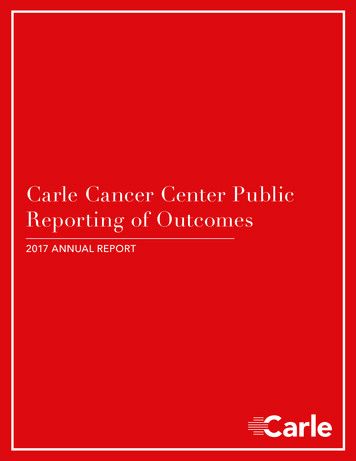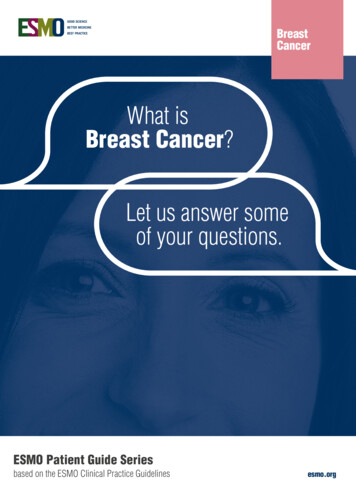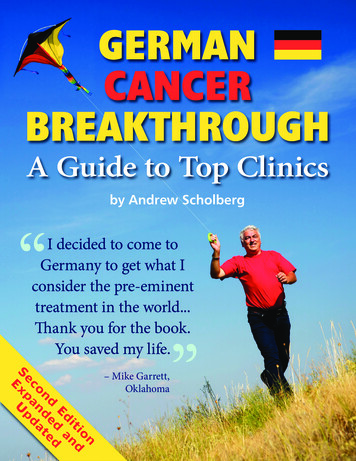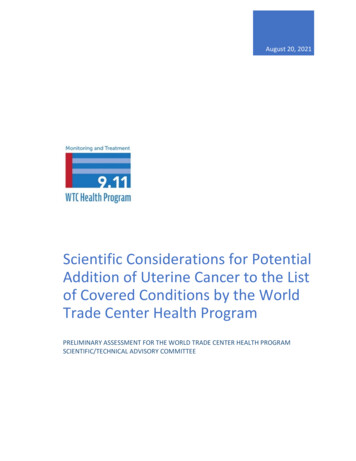
Transcription
Support for People with CancerCancer Pain ControlU.S. Department of Health & Human Services National Institutes of Health
For more information . . .This booklet is only one of many free booklets for people with cancer.Here are some others you and your loved ones may find useful: Chemotherapy and You Coping With Advanced Cancer Eating Hints for Cancer Patients If You Have Cancer: What You Should Know About Clinical Trials Radiation Therapy and You Taking Time Thinking About Complementary and Alternative Medicine When Cancer Returns When Someone You Love Is Being Treated for Cancer When Someone You Love Has Advanced Cancer When Your Parent Has CancerThese free booklets are available from the National Cancer Institute(NCI). To order or download, call 1-800-4-CANCER (1-800-422-6237)or visit www.cancer.gov. (See page 35 of this booklet for moreresources.)For information about your specific type of cancer, see NCI’s PhysicanData Query (PDQ ) database at http://www.cancer.gov.
Cancer Pain ControlCancer pain can be managed.Having cancer doesn’t mean that you’ll have pain. But if you do, you can managemost of your pain with medicine and other treatments.This booklet will show you how to work with your doctors, nurses, and others tofind the best way to control your pain. It will discuss causes of pain, medicines, howto talk to your doctor, and other topics that may help you. As a team, you and yourdoctor can work together to find the best pain control plan for you.We are using the term “health care team.”In this booklet, your “health care team” can mean any of the professionals you seeas part of your medical care. These may include your oncologist, your family doctor,nurses, palliative care specialists, physical therapists, pharmacists, oncology socialworkers, clergy members, and others.“I thought that I had to live with the pain, butit got to the point where I just couldn’t handleit anymore. My doctor and I talked about itand he decided to change my medicine. I’m notsaying that I’m always pain free, but it’s a lotbetter now.” —JohnProduct or brand names that appear in this booklet are for example only. The U.S.Government does not endorse any specific product or brand. If products or brands arenot mentioned, it does not mean or imply that they are not satisfactory.
Table of Contents1. What You Should Know About Treating Cancer Pain . 12. Types and Causes of Cancer Pain . 33. Talking About Your Pain . 54. Your Pain Control Plan. 95. Medicines To Treat Cancer Pain .11Questions to ask your health care team about yourpain medicine:. 20Other treatments to relieve pain. 226. Additional Ways to Control Pain. 237. Your Feelings and Pain. 288. Financial Issues . 31Reflection. 34Resources . 35Pain Control Record. 38How to Use Imagery . 40Relaxation Exercises . 41ii
CHAPTER 1What You Should Know AboutTreating Cancer PainYou don’t have to accept pain.People who have cancer don’t always have pain. Everyone is different. But if you dohave cancer pain, you should know that you don’t have to accept it. Cancer paincan almost always be relieved. Working together, you and your doctor can manageyour pain.The most important things to keep in mind: Your pain can be managed. Controlling your pain is part of cancer treatment. Talking openly and sharing information with your doctor and health careteam will help them manage your pain. The best way to control pain is to stop it from starting or keep it fromgetting worse. There are many different medicines to control pain. Everyone’s pain controlplan is different. Keeping a record of your pain will help create the best pain control planfor you. Take your medicines as directed. Do not save them for later or changethe dose.1
Palliative care and pain specialists can help.Cancer pain can be reduced so that you can enjoy your normal routines and sleepbetter. It may help to talk with a palliative care or pain specialist.Pain and palliative care specialists are experts in pain control. Palliative carespecialists treat the symptoms, side effects, and emotional problems of both cancerand its treatment. They will work with you to find the best way to manage your pain.Ask your doctor or nurse to suggest someone. Or contact one of the following forhelp finding a specialist in your area: Cancer center Your local hospital or medical center Your primary care provider People who belong to pain support groups in your area The Center to Advance Palliative Care, www.getpalliativecare.org(for lists of providers in each state)When cancer pain is not treatedproperly, you may be:2 Tired Depressed Angry Worried Lonely StressedWhen cancer pain is managedproperly, you can: Enjoy being active Sleep better Enjoy family and friends Feel like eating Enjoy sexual intimacy Be in a better mood
CHAPTER 2Types and Causes of Cancer PainCancer pain can range from mild to very severe. Some days it can be worse thanothers. It can be caused by the cancer itself, the treatment, or both.You may also have pain that has nothing to do with your cancer. Some people haveother health issues or headaches and muscle strains. Always check with your doctorbefore taking any over-the-counter medicine to relieve everyday aches and pains. Thiswill help ensure that there will be no interactions with other drugs or safety concernsto know about.Different types of pain.Here are the common terms used to describe different types of pain: Acute pain ranges from mild to severe. It comes on quickly and lasts ashort time. Chronic pain ranges from mild to severe and persists or progresses over along period of time. Breakthrough pain is an intense rise in pain that occurs suddenly or is feltfor a short time. It can occur by itself or in relation to a certain activity. Itmay happen several times a day, even when you’re taking the right dose ofmedicine. For example, it may happen as the current dose of your medicine iswearing off.What causes cancer pain?Cancer and its treatment cause most cancer pain. Major causes of pain include: Pain from medical tests. Some methods used to diagnose cancer or see howwell treatment is working can be painful. Examples may be a biopsy, spinaltap, or bone marrow test. Don’t let concerns about pain stop you from havingtests done. Talk with your doctor ahead of time about the steps that will betaken to lessen any potential pain. Pain from a tumor. If the cancer grows bigger or spreads, it can cause painby pressing on the tissues around it. For example, a tumor can cause pain if itpresses on bones, nerves, the spinal cord, or body organs.3
Pain from treatment. Chemotherapy, radiation therapy, surgery, and othertreatments may cause pain for some people. Some examples of pain fromtreatment are: Neuropathic pain. This is pain that may occur if treatment damages thenerves. The pain is often burning, sharp, or shooting. The cancer itself canalso cause this kind of pain. Phantom pain. You may still feel pain or other discomfort coming froma body part that has been removed by surgery. Doctors aren’t sure why thishappens, but it’s real. Joint pain (called arthralgia). This kind of pain is associated with theuse of aromatase inhibitors, a type of hormonal therapy.How much pain you feel depends on different things. These include the cause of thepain and how you experience it in your body. Everyone is different.When to call your doctors right awayListen to your body. If you notice that everyday actions,such as coughing, sneezing, moving, walking, or standing,suddenly causes new pain or your pain gets worse, tell yourdoctors right away. Also let them know if you have unusualrashes or bowel or bladder changes And always call if youhave problems breathing.4
CHAPTER 3Talking About Your PainPain control is part of treatment. Talking openly is key.The most important member of the team is you. You’re the only one who knows whatyour pain feels like. Talking about pain is important. It gives your health care teamthe feedback they need to help you feel better.Some people with cancer don’t want to talk about their pain because they: Think that they’ll distract their doctors from working on ways to help treattheir cancer Worry that they won’t be seen as “good” patients Worry that they won’t be able to afford pain medicineAs a result, people sometimes get so used to living with their pain that they forgetwhat it’s like to live without it.Tell your health care team if you’re: Taking any medicine to treat other health problems Taking more or less of the pain medicine than prescribed Allergic to certain drugs Using any over-the-counter medicines, home remedies, or herbal oralternative therapiesThis information could affect the pain control plan your doctor suggests for you.If you feel uneasy talking about your pain, bring a family member or friend tospeak for you. Or let your loved one take notes and ask questions. Remember, opencommunication between you, your loved ones, and your health care team will lead tobetter pain control.5
Describing your pain.The first step in getting your pain under control is talking honestly about it.Try to talk with your health care team and your loved ones about what you’re feeling.You will be asked to describe and rate your pain. This provides a way for your doctorto assess your pain threshold, which is the point at which a person becomes awareof pain. Knowing this will help measure how well your pain control plan is working.Your doctor may ask you to describe your pain in a number of ways. A pain scale isthe most common way. The scale uses the numbers 0 to 10, where 0 is no pain, and10 is the worst. Some doctors show their patients a series of faces and ask them topoint to the face that best describes how they feel. You will also need to talk aboutany new pain you feel.This also means telling them: Where you have pain What it feels like (sharp, dull, throbbing, constant, burning, or shooting) How strong your pain is How long it lasts What lessens your pain or makes it worse When it happens (what time of day, what you’re doing, and what’s going on) If it gets in the way of daily activitiesMany patients have found it helpful to keep a record of their pain. See thechart on page 38 for an example. Some people use a pain diary or journal. Otherscreate a list or a computer spreadsheet. Choose the way that works best for you.Your record could list: When you take pain medicine Name and dose of the medicine you’retaking Any side effects you have How much the medicine lowers the painlevel How long the pain medicine works Other pain relief methods you use tocontrol your pain Any activity that is affected by pain, ormakes it better or worse Things that you can’t do at all because of the pain6Share your record with your health care team. It can help them figure out how helpfulyour pain medicines are, or if they need to change your pain control plan.
Here are some ways your health care team may ask youto describe or rate your eratePain10WorstPossible nPain As Bad As ItCould Possibly Be0246810No hurtHurts alittle bitHurts alittle moreHurtseven moreHurts awhole lotHurtsworst0–10 Numeric Pain Intensity Scale, Simple Descriptive Pain Intensity Scale, and Visual Analog Scale(VAS): Acute Pain Management Guideline Panel. Acute Pain Management in Adults: OperativeProcedures. Quick Reference Guide for Clinicians AHCPR Pub. No. 92-0019. Rockville, MD: Agency forHealth Care Policy and Research, Public Health Service, U.S. Department of Health and Human Services.“Faces” Pain Scale adapted with permission from Hockenberry MJ, Wilson D, Winkelstein ML: Wong’sEssentials of Pediatric Nursing, ed. 7, St. Louis, 2005, p. 1259. Used with permission. Copyright, Mosby.7
If you have beliefs about medicines, share them.Some people don’t want to take medicine, even when it’s prescribed by the doctor.Taking it may be against religious or cultural beliefs. Or there may be other personalreasons why someone won’t take medicine.If you feel any of these ways about pain medicine, it’s important to share your viewswith your health care team. If you prefer, ask a friend or family member to sharethem for you. Talking openly about your beliefs will help your health care team find aplan that works best for you.“It makes sense. If you don’ttell someone about your pain,then no one can help you! Andthe pain won’t go away byitself.” — Joe8
CHAPTER 4Your Pain Control Plan“It took a few visits to my health care team to get my pain undercontrol. But by trying different medicines and doses, I now have a painplan that works for me.” —MichelleMake your pain control plan work for you.Your pain control plan will be designed for you and your body. Everyone has adifferent pain control plan. Even if you have the same type of cancer as someone else,your plan may be different.Take your pain medicine on schedule to keep the pain from starting or getting worse.This is one of the best ways to stay on top of your pain. Do not skip doses. Once youfeel pain, it’s harder to control and may take longer to get better.Here are some other things you can do: Bring your list of medicines to each visit. Bring your pain record or diary. If you are seeing more than one doctor, make sure each one sees your list ofmedicines, especially if he or she is going to change or prescribe medicine. Don’t wait for the pain to get worse. Never take someone else’s medicine or share medicine. What helped a friendor relative may not help you. Do not get medicine from other countries or the Internet without telling yourdoctor. Ask your doctor to change your pain control plan if it isn’t working.The best way to control pain is to stop it before it starts orprevent it from getting worse.Don’t wait until the pain gets bad or unbearable before taking your medicine. Pain iseasier to control when it’s mild. And you need to take pain medicine often enough tostay ahead of your pain. Follow the dose schedule your doctor gives you. Don’t try to“hold off” between doses. If you wait:9
Your pain could get worse. It may take longer for the pain to get better or go away. You may need larger doses to bring the pain under control.Keep a list of all your medicines.Make a list of all the medicines you’re taking. If you need to, ask a member of yourfamily or health care team to help you. Bring this list of medicines to each visit.(See page 39 for a sample list.)Your health care team needs to know what you take and when. Tell them each drugyou’re taking, no matter how harmless you think it might be. Even over-thecounter medicines, herbs, and supplements can interfere with cancer treatment. Orthey could cause serious side effects or reactions.How to tell when you need a new pain control planHere are a few things to watch out for and tell your health care team about: Your pain isn’t getting better or going away. Your pain medicine doesn’t work as long as your doctor said it would. You have breakthrough pain. You have side effects that don’t go away. Pain interferes with things like eating, sleeping, or working. The schedule or the way you take the medicine doesn’t work for you.If you have trouble breathing, dizziness, or rashes, call your doctor rightaway. You may be having an allergic reaction to the pain medicine.Don’t give up hope. Your pain can be managed.If you’re still having pain that is hard to control, you may want to talk with yourhealth care team about seeing a pain or palliative care specialist (see page 2).Whatever you do, don’t give up. If one medicine doesn’t work, there is almostalways another one to try. And unlike other medicines, there is no “right” dose formany pain medicines. Your dose may be more or less than someone else’s. The rightdose is the one that relieves your pain and makes you feel better.10
CHAPTER 5Medicines To Treat Cancer PainThere is more than one way to treat pain.Your doctor prescribes medicine based on the kind of pain you have and how severe itis. In studies, these medicines have been shown to help control cancer pain.Doctors use three main groups of drugs for pain: over-the-counter,prescription and non-opioid medicines, and opioids. You may also hear theterm analgesics used for these pain relievers. Some are stronger than others. It helpsto know the different kinds of medicines, why and how they’re used, how you takethem, and what side effects you might expect.1. Over-the-Counter (OTC) for mild to moderate painOver-the-Counter (OTC) drugs can be used to treat mild to moderate pain. Ona scale of 0 to 10, an OTC may be used if you rate your pain from 1 to 4. Thesemedicines are stronger than most people realize. In many cases, they are all you’llneed to relieve your pain. You just need to be sure to take them regularly.You can buy most OTC drugs without a prescription. But you still need to talkwith your doctor before taking them. Some of them may have things added tothem that you need to know about. And they do have side effects. Common ones,such as nausea, itching, or drowsiness, usually go away after a few days. Do not takemore than the label says unless your doctor tells you to do so.OTC drugs include:Acetaminophen, which you may know as Tylenol Acetaminophen reduces pain. It is not helpful with inflammation. Most of the time,people don’t have side effects from a normal dose of acetaminophen. However, it’simportant to know: Regularly taking large doses can damage the liver Drinking alcohol with this drug may cause liver damageAlways tell the doctor if you’re taking acetaminophen because: Sometimes it’s used in other medicines, so you may be taking more than youshould Acetaminophen can lower a fever. If you’re on chemotherapy, your doctor maynot want you to take the medicine too often. It could cover up a fever, whichwould hide the fact you might have an infection.11
Nonsteroidal anti-inflammatory drugs (NSAIDs), such as ibuprofen (which youmay know as Advil or Motrin ) and aspirinNSAIDs help control pain and inflammation. With NSAIDs, the most commonside effect is stomach upset or indigestion, especially in older people. Eating food ordrinking milk when you take these drugs may stop this from happening.Other side effects NSAIDs may cause are: Bleeding of the stomach lining (especially if you drink alcohol) Kidney problems, especially in the elderly or those with existing kidneyproblems Heart problems, especially in those who already have heart disease (However,aspirin does not cause heart problems) Blood clotting problems, which means it’s harder to stop bleeding after you’vecut or hurt yourself.When taking NSAIDS, tell your doctor if: Your stools become darker than normal You notice bleeding from your rectum You have an upset stomach You have heartburn symptoms You cough up bloodImportant to remember when taking NSAIDsSome people have conditions that NSAIDs can make worse. In general, you shouldavoid these drugs if you: Are allergic to aspirin Are on steroid medicines Have stomach ulcers or a history of ulcers, gout, or bleeding disorders Are taking prescription medicines for arthritis Have kidney problems Have heart problems Are planning surgery within a week Are taking blood-thinning medicine (such as heparin or Coumadin )Talk to your health care team before taking NSAIDS. As with acetaminophen,NSAIDs can lower fever. If you’re on chemotherapy, your doctor may not want youto take them too often. The medicines can cover up a fever, hiding the fact that youmight have an infection.12
2. Other prescription medicines for painDoctors also prescribe other types of medicine to relieve cancer pain. They can beused along with non-opioids and opioids. Some include: Antidepressants. Some drugs can be used for more than one purpose. Forexample, antidepressants are used to treat depression, but they may also helprelieve tingling and burning pain. Nerve damage from radiation, surgery, orchemotherapy can cause this type of pain. Antiseizure medicines (anticonvulsants). Like antidepressants,anticonvulsants or antiseizure drugs can also be used to help control tinglingor burning from nerve injury. Steroids. Steroids are mainly used to treat pain caused by swelling.3. Opioids — for moderate to severe painIf you’re having moderate to severe pain, your doctor may recommend that you takestronger drugs called opioids. Opioids are sometimes called narcotics. You must havea doctor’s prescription to take them.Opioids may be long acting or short acting. Short acting means that the drugbegins working quickly and is prescribed as needed depending on your pain levels.Long acting drugs are absorbed in the body more slowly, but they last longer and aretaken regularly as prescribed. Short acting is often prescribed in addition with longacting to treat breakthrough pain (page 3).Common short-acting opioids include: Buprenorphine Methadone Codeine Morphine Diamorphine Oxycodone Fentanyl Oxymorphone Hydrocodone Tapentadol Hydromorphone (e.g., Dilaudid ) TramadolLong-acting opioids include: MS Contin Oxycontin Duragesic 13
Getting relief with opioidsOver time, people who take opioids for pain sometimes find that they need to takelarger doses to get relief. This is caused by more pain, the cancer getting worse, ormedicine tolerance (see below). When a medicine doesn’t give you enough pain relief,your doctor may increase the dose and how often you take it. He or she can alsoprescribe a stronger drug. Both methods are safe and effective under your doctor’scare. Do not increase the dose of medicine on your own.Tolerance, physical dependence, and addictionPeople with cancer often need opioids for pain. When your health care teamdiscusses your options for taking opioids, you may hear the terms tolerance,physical dependence, and addiction. It may be helpful to understand thedifference between the three.ToleranceSome patients with cancer pain stop getting pain relief from opioids if they takethem for a long time. This is called tolerance. The development of tolerance is notaddiction. Larger amounts or a different opioid may be needed if your body stopsresponding to the original dose. Your health care team will work with you to eitherincrease your dose or change your medicine.Physical dependencePhysical dependence occurs when the body gets used to a certain level of the opioidand has withdrawal symptoms if the drug is suddenly stopped or taken in muchsmaller doses. Withdrawal consists of unpleasant physical or psychological symptomssuch as anxiety, sweating, nausea, and vomiting, to name a few. This is not the sameas addiction, though people with addiction will experience physical dependence.Physical dependence can happen with the chronic use of many drugs—includingmany prescription drugs, even if taken as instructed. (See page 18 for more onwithdrawal.)AddictionAddiction is a chronic disease characterized by: Compulsive drug seeking The inability to stop use despite harmful consequences Failure to meet work, social, or family obligations Sometimes tolerance and withdrawal14
Although many patients who are prescribed opioids for cancer pain use them safely,some patients are at greater risk for addiction than others.It’s very important for you to share any personal or family history of drug or alcoholabuse with your health care team. Other factors in your life may also increase yourrisk of addiction. For more information, go to the National Institute on Drug Abuseat www.drugabuse.gov.It’s common for cancer patients to worry that they will become addicted to painmedicines. Your doctor will carefully prescribe and monitor your opioid doses so thatyou’re treated for pain safely. Do not be afraid to take these medicines. Controllingyour pain is one of the goals for your care.Managing and preventing side effectsSome pain medicines may cause: Constipation (trouble passing stools) Drowsiness (feeling sleepy) Nausea (upset stomach) Vomiting (throwing up)Side effects vary with each person. It’s important to talk to your doctor often about anyside effects you’re having. If needed, he or she can change your medicines or the dosesyou’re taking. They can also add other medicines to your pain control plan to help yourside effects.Don’t let any side effects stop you from getting your pain managed. Your health careteam can talk with you about other ways to relieve them. There are solutions to gettingyour pain under control.Less common side effects include: Dizziness Confusion Breathing problems (Call your doctor right away if this occurs) Itching Trouble urinating Altered sleep patterns (nightmares)15
ConstipationAlmost everyone taking opioids has some constipation. This happens because opioidscause the stool to move more slowly through your system, so your body takes moretime to absorb water from the stool. The stool then becomes hard. Keep in mind thatconstipation will only go away if it’s treated.You can control or prevent constipation by taking these steps: Ask your doctor about giving you laxatives and stool softeners (drugs to helpyou pass stool from your body) when you first start taking opioids. Takingthese right when you start taking pain medicine may prevent the problem. Drink plenty of liquids. Drinking 8 to 10 glasses of liquid each day will helpkeep stools soft. Eat foods high in fiber, including raw fruits with the skin left on, vegetables,and whole grain breads and cereals. Exercise as much as you are able. Any movement, such as light walking,will help. Call your doctor if you have not had a bowel movement in 2 days or more.DrowsinessSome opioids cause drowsiness. Or, if your pain has kept you from sleeping, you maysleep more at first when you begin taking opioids. The drowsiness could go away aftera few days.If you are tired or drowsy: Don’t walk up and down stairs alone. Don’t drive, use machines or equipment, or anything else that requires focus.Call your doctor if the drowsiness doesn’t go away after a few days. He or she mayadjust the dose you’re taking or change drugs.16
Nausea and vomitingNausea and vomiting may go away after a few days of taking opioids. However, if yournausea or vomiting prevents you from taking your medicine, or affects your ability toeat and drink, call your doctor right away.These tips may help: Stay in bed for an hour or so after taking your medicine if you feel sick whenwalking around. This kind of nausea is like feeling seasick. Some over-thecounter drugs may help, too. But be sure to check with your doctor beforetaking any other medicines. Your doctor may want to change or add medicines, or prescribe anti-nauseadrugs. Ask your doctor if something else could be making you feel sick. It might berelated to your cancer or another medicine you’re taking. Constipation canalso add to nausea.Starting a new pain medicineSome pain medicines can make you feel sleepy when you first take them. This usuallygoes away within a few days. Also, some people get dizzy or feel confused. Tell yourdoctor if any of these symptoms persist. Changing your dose or the type of medicinecan usually solve the problem.17
Important points to remember when taking pain medicineAll drugs must be taken carefully. Here are a few things to remember when you aretaking opioids: Take your medicines as directed. Don’t split, chew, or crush them, unlesssuggested by your doctor. Doctors will adjust the pain medicine dose so that you get the rightamount for your body. That’s why it’s important that only one doctorprescribes your opioids. Make sure that you bring your list of medicines toeach visit. That way, your health care team is aware of your pain control plan. Combining pain medicine with alcohol or tranquilizers can be dangerous.You could have trouble breathing or feel confused, anxious, or dizzy.Tell your doctor how much and how often you: Drink alcohol Take tranquilizers, sleeping pills, or antidepressants Take any other medicines that make you sleepy Avoid withdrawal: slowly reduce opioids, never stop them suddenly. Youmay be able to take less medicine when the pain gets better. You may even beable to stop taking opioids. But it’s important to stop taking opioids slowly,with your doctor’s guidance, because: When pain medicines are taken for long periods of time, your body getsused to them. If the medicines are stopped or suddenly reduced, a condition calledwithdrawal may occur. Withdrawal symptoms vary with each person, but you may start feelinglike you have the flu. You may sweat, have diarrhea, feel nervous, or haveother symptoms. Stopping your pain medicines slowly prevents withdrawal symptoms. Thisis why the doses should be lowered slowly.18
Be sure to ask your health care team about the common side effectsof these medicines.How medicine is givenTo relieve cancer pain, doctors often prescri
Pain and palliative care specialists are experts in pain control. Palliative care specialists treat the symptoms, side effects, and emotional problems of both cancer and its treatment. They will work with you to find the best way to manage your pain. Ask your doctor or nurse to suggest someone. Or contact one of the following for











